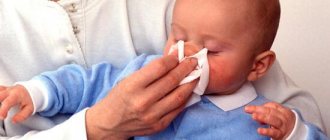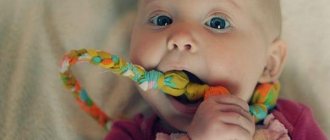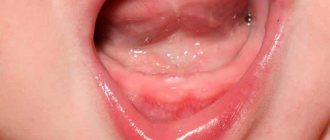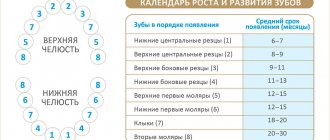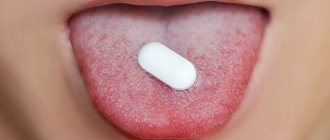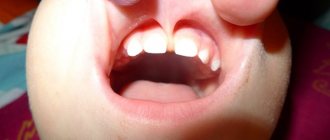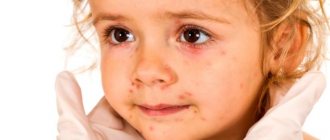When snot appears in a baby, when other signs such as fever, cough, red throat are absent, we can say that the cause is a runny nose during teething. After the teeth appear, the snot usually disappears. During this period, the baby's immune system is weakened, which can cause a risk of contracting a viral infection.
- The connection between runny nose and teething
- Causes of runny nose during teething in children
- Signs of snot in a child
- Features associated with ARVI
- How to help a child
- What parents should not do when treating snot during teething in children
Causes of runny nose during teething in children
A newborn’s first teeth appear between 4 and 7 months of life; usually by the age of three they fill the child’s entire mouth. During this period, the baby is introduced to the first complementary foods and the proportion of breast milk decreases, which leads to a weakening of the child’s immunity . After all, milk contains a large number of antibodies, because they protect the baby from viruses.
The period when teeth are cut becomes difficult not only for the baby, but also for the whole family. The child becomes restless, cries and constantly puts foreign objects into his mouth. In addition, the baby develops a runny nose .
Rhinorrhea during teething: causes
Baby teeth usually appear in babies at the age of 5-9 months, while the process of teething can begin much earlier - from 3-4 months. The gradual eruption of dental crowns is always accompanied by spontaneous opening of the gums.
Baby teething
This process is quite painful and gives the child a lot of unpleasant sensations and discomfort, so most children during this period become whiny, restless, and capricious. At the same time, almost 60% of infants experience another symptom that is considered characteristic of the eruption of baby teeth in the first year of life - a runny nose.
Teething is often accompanied by a runny nose
There are several reasons that can provoke the appearance of rhinorrhea during teething.
The process and timing of teething depend not only on inherited genetic parameters; the timing of teething can be influenced by external and internal factors. For example, climatic conditions, the course of pregnancy and the nature of nutrition of the mother and child after birth, illnesses of the baby, and more. Read more about the teething schedule for infants on our website.
Reduced immunoresistance
Weakening of immune function during the eruption of dental crowns is a natural reaction of the body to an internal factor that is a mediator of stress. Dentists note that most often, a pronounced immune disorder during this period is observed in children whose teeth appear too early (before 4 months), or, conversely, too late (after 10 months). The risk of a viral or bacterial infection is higher if the following factors are present:
- insufficient hygiene of the baby’s hands and skin;
- poor processing of children's bedding and underwear, toys, feeding utensils, pacifiers;
- irregular wet cleaning in the apartment (especially in the children's room);
- non-compliance with standards for ventilation and humidification of rooms in which the child spends most of his time;
- frequent appearance in crowded places.
Oral hygiene in children
If a child begins to teethe, contact with strangers or people who have recently had a respiratory disease should be temporarily prevented, since the risk of infection during this period is quite high for all children.
While your child is teething, it is worth protecting him as much as possible from possible airborne infections.
Note! Compliance with increased preventive measures during teething is recommended for children suffering from congenital autoimmune diseases (cystic fibrosis, agranulocytosis, diabetes mellitus, etc.).
Strengthening secretory function
A natural protective mechanism during teething is to increase the activity of secretory glands that produce salivary and muconasal secretions. Rhinorrhea is observed mainly in infants with manifestations of hypersalivation (increased salivation), since anatomically the nasopharynx and oropharynx have a similar structure and are located in close proximity to each other.
A runny nose usually bothers babies with increased salivation.
In this case, muconasal mucus is produced by surface epithelial cells located in the mucous membranes of the nose. The secretion contains not only water, mucus and epithelial particles, but also mucin - gel-like high molecular weight mucoproteins that contain a large amount of acidic polysaccharides. If the secretory glands work too actively, the amount of mucus secreted increases several times, which leads to its removal from the nasal cavity through the anatomical openings - the nostrils. In some cases, such snot can flow into the throat along the back wall of the pharynx, causing a cough, which many parents perceive as a symptom of a respiratory infection.
- How to deal with unpleasant odors in the home of a seriously ill person
Coughing may be normal during teething
Stimulation of blood circulation
During teething, the flow of blood and lymph to the vessels located in the oral cavity increases. Increased blood and lymph circulation also occurs in the vessels of the nasal cavity, which has a stimulating effect on the secretory glands and causes increased secretion of muconasal mucus, which is commonly called snot.
Clinical features
“Dental” rhinitis” (“dental runny nose”), which is a type of physiological runny nose, must be distinguished from pathological rhinitis, which can be infectious, allergic and neurovegetative in nature. The physiological secretion of nasal mucus against the background of changes occurring in the child’s body during the period of teething crowns has certain clinical features that need to be paid attention to. Such a runny nose is not accompanied by an increase in temperature, the release of thick yellow, brown or green snot, or the appearance of allergic reactions in the form of a rash or itchy skin.
If the baby has snot and saliva, but there is no fever, it means that another baby tooth will appear soon.
In this case, a dental runny nose may well occur against the background of a slight change in stool due to increased secretion of the salivary glands and the ingestion of a large amount of saliva, which mixes with food and dilutes its consistency. A deterioration in general well-being is also possible, since the process of teeth appearing is quite painful and unpleasant for the child. Physiological rhinitis may also be accompanied by other pathological symptoms, for example, cough, sleep disturbance or refusal to eat, but only a doctor can establish their relationship with the possible presence of infectious pathogens in the body.
Your baby may be fussy and have trouble sleeping during teething.
Signs of snot in a child
Symptoms of snot on teeth are:
- increased salivation,
- the child does not sleep well,
- the baby's appetite has decreased,
- diarrhea appeared.
During teething, the baby's temperature may rise . This is explained by a large accumulation of active components. If the temperature rises above 38 and lasts more than three days, parents should definitely contact their pediatrician.
A baby’s snot may also be accompanied by a cough. A large amount of mucus forms in the child’s mouth, which, when it gets into the back of the throat, irritates it and causes a cough. In this case, you also need to make sure that the cough is not caused by a virus, but is associated with teething.
Is it necessary to treat “tooth” snot?
One of the most common mistakes that many parents make if their child develops snot is to independently use various medications to combat this problem. The first place in this list is traditionally occupied by various anticongestive drugs that cause constriction of blood vessels and are intended to relieve swelling in the nasal cavity. Such drugs include drops “Nazivin”, “Naphthyzin”, “Xylometazoline” and other drugs with a similar mechanism of action.
The main component of the drug is oxymetazoline hydrochloride
Anticongestants have a large number of side effects, the main of which are the rapid addictive effect and gradual atrophy of the nasal mucosa, which can ultimately lead to the development of chronic atrophic rhinitis. The use of these medications is justified only in severe cases, when the child cannot breathe normally due to severe swelling of the mucous membrane, which happens mainly with infectious rhinitis. Antihistamines that block the production of the main mediator of inflammatory reactions (histamine) are also unacceptable for the treatment of physiological rhinorrhea associated with teething.
Important! Despite the fact that the use of traditional remedies for snot associated with teething is not recommended, it is impossible to completely refuse treatment, since stagnation of mucus in the nose creates an excellent breeding ground for various bacteria and can cause serious complications: otitis media, bronchitis, etc. .d.
Features associated with ARVI
If snot appears on the teeth, parents need to consult a pediatrician or understand that there are no reasons for concern. Komarovsky believes that a runny nose during teething cannot always be treated.
Viral runny nose can be characterized by the following reasons:
- a child, even before the causes of the disease appear, becomes lethargic, his appetite worsens, weakness and pain in the muscles may be observed,
- an increase in body temperature to high values. Although a temperature may be observed during teething, the fever is more pronounced with the virus. If the cause is teeth, then after a few days the temperature disappears without a trace,
- snot, dry or wet cough can be the cause of upper or lower respiratory tract disease. A dry or wet cough that does not go away within three days is possibly viral in nature. Komarovsky believes that teeth in combination with a cough can be the cause of the disease, and hard breathing without wheezing is a residual symptom of a previous viral disease,
- An infectious runny nose is accompanied by impaired nasal breathing and a large amount of mucus secreted. With a virus, the discharge can be mucopurulent, but when it erupts, it is usually transparent.
But should the process of teething also be accompanied by a runny nose and nasal congestion?
No, such manifestations should not happen. And if nasal congestion is still present during teething, then first of all it is necessary to exclude the parallel development of a respiratory infection, as well as an allergic reaction, especially if you introduce complementary foods or new foods to the child, or if there is an increased number of respiratory allergens in the house, for example, the presence of domestic animals.
If there is neither one nor the other, then the vessels of the child’s nasal mucosa are really dilating and swelling appears due to such a provoking factor as teething, which should not normally be the case. Therefore, many otorhinolaryngologists are inclined to conclude that this is one of the signs of a child’s possible predisposition to vasomotor rhinitis. This vasomotor reaction usually goes away within 2-3 days after eruption.
How to help a child
A runny nose during teething, as Dr. Komarovsky explains, needs to be treated for inflamed gums. To do this, you can use anti-inflammatory gels - Kamistad and Kalgel. If the symptoms do not disappear for a long time, then the child can be given antiviral drugs approved for teething.
In order for your baby to recover faster, he needs:
- use narrowing drops for no more than six days,
- give plenty of fluids to drink, especially raspberry tea,
- it is necessary to maintain optimal air temperature and humidity in the baby’s room,
- do not force him to eat if the child has no appetite,
- If necessary, maintain bed rest.
To alleviate a child’s condition with a runny nose and snot, he can be helped as follows:
- rinse the nose with saline solution to relieve inflammation and remove mucus,
- use an aspirator to remove mucus,
- If your nose is stuffy, you can use drops to relieve swelling of the nasal mucosa.
Drops that can be used by children when teething are Otrivin, Nazivin and Aqualor.
You can constantly rinse your child’s nose with saline solution several times a day, because it is harmless and has no contraindications.
Sometimes the contents of the child’s nasal sinuses dry out, full access to breathing ceases and moisture occurs. To prevent the occurrence of a runny nose, it is necessary to avoid the appearance of dry crusts.
To prevent dry crusts in a child, you need to:
- rinse thoroughly and constantly moisturize your nose,
- prevent the appearance of mucus with special preparations.
